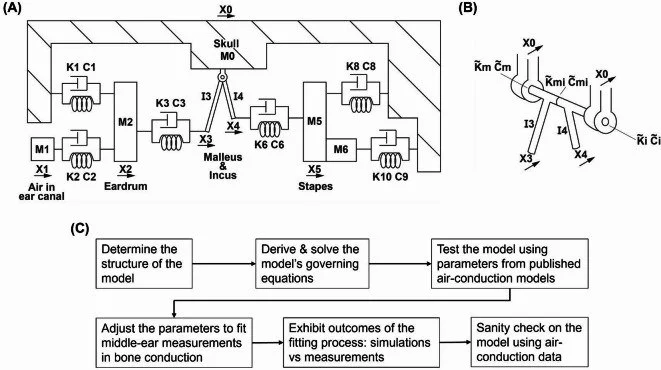By Harsh Hariani and Timothy Balmer, Ph.D.
Have you ever wondered how your body can rapidly respond to maintain your balance after a slip? The nearly instantaneous movement that maintains your balance depends on sensorimotor processing in your brain.
Four patterns of connections between UBC subtypes were identified, showing how they modify firing patterns. Intermediate UBCs can extend or delay firing in postsynaptic UBCs, affecting their response. Credit: Hariani et al./eLife
In the case of a slip, the vestibular system in your inner ear sends vestibular signals to your brain that is at odds with what your brain had predicted the movement would feel like. This mismatch between the brain’s prediction and the sensory feedback representing the slip causes the brain to recalculate how to move to correct your body’s posture and prevent a fall.
The cerebellum, located at the back of your head, is the part of your brain that is responsible for coordinating movement and balance. It does so by integrating incoming sensory information, which requires specialized neuronal circuits.
We studied one critical neuron type in the vestibular cerebellar circuit–the unipolar brush cell. UBCs can be classified into two distinct subtypes–ON and OFF, depending on whether their firing rate increases (ON) or decreases (OFF) in response to sensory input. Previous studies have suggested that UBCs synapse with other UBCs, but it was unclear if these connections are subtype-specific.
Our primary goal was to identify how the two different subtypes of UBCs are connected to one another because signal processing in the cerebellum—and thus balance and motor coordination—depends on signal transformations that occur in these circuits. We utilized transgenic mouse lines that label ON or OFF UBCs to explore their connectivity, structure, and function using electrophysiology, microscopy, and computational modeling.
In our paper published in eLife in January 2024, we confirmed that UBCs target one another, and we report for the first time that connections exist between their own UBC subtype as well as the other subtype. We built computer models of these feed-forward networks of UBCs to predict how they could transform neuronal activity–revealing that they may introduce delays or increase the length of firing responses, and presumably extend vestibular sensory representations.
Our findings show how UBC circuits are organized, which is critical to understanding vestibular sensory integration in the cerebellum. Future work that builds upon this research will include an analysis of how these neurons develop their unique anatomical and electrophysiological properties and how they contribute to balance and orientation in behavioral experiments. This research is necessary for understanding normal cerebellar function as well as disorders that may arise from cerebellar dysfunction, such as ataxia, nystagmus, or vertigo.
Harsh Hariani (near left) is a doctoral student in the Arizona State University lab of Timothy Balmer, Ph.D. (far left), who is a 2022 Emerging Research Grants recipient in the area of Ménière’s disease, which was renewed for a second year in 2023.
Balmer is also a 2017 ERG scientist in the area of tinnitus, generously funded by the Les Paul Foundation.








Cochlear implants work differently from hearing aids. Instead of making sounds louder, they bypass the damaged parts of the inner ear and send signals directly to the brain, allowing individuals to perceive sound more clearly.